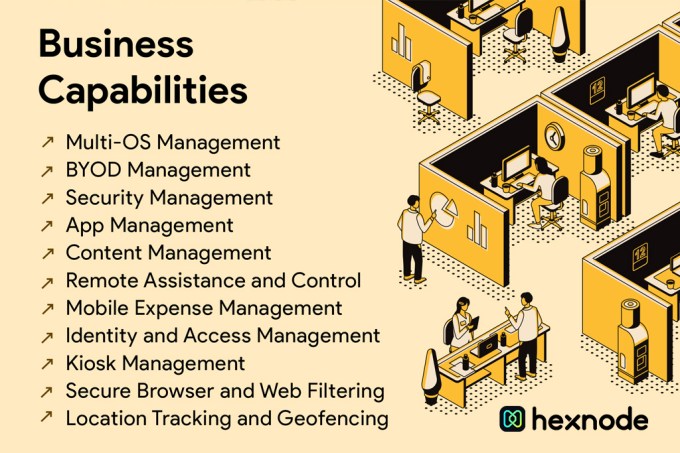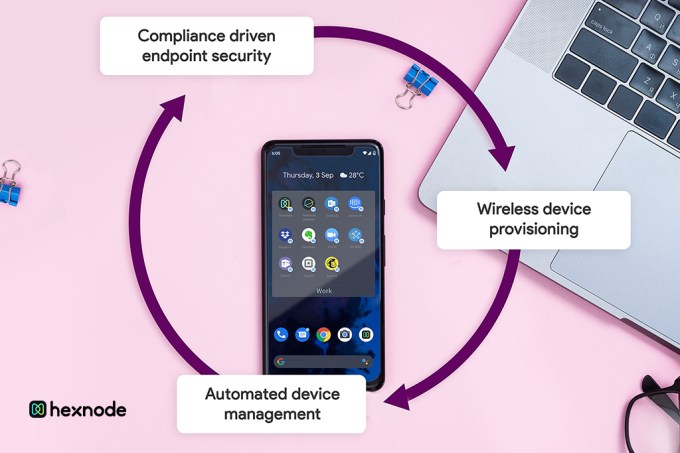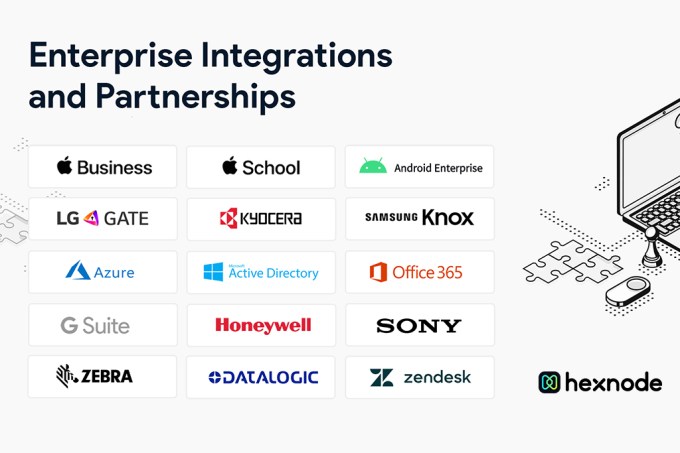With enterprises taking to the cloud, and growing regulations around data protection, endpoint security has become a normative aspect of running a business. And Hexnode has been at the center of this change, driving compliance and improving user experience around device management. Hexnode’s Unified Endpoint Management (UEM) solution empowers IT by bringing together users, devices, apps and content under one central console.
Forrester defines UEM as “products that provide a centralized policy engine for managing and securing all employee devices and apps from a single console.”
To understand what Unified Endpoint Management solutions can do and how it all fits into the overall scheme of enterprise security and IoT, we need to take a deeper dive into Hexnode UEM.
Hexnode UEM incorporates mobile device management, application management, content management, security management, modern PC management, and identity and access management.

Mobile device management is all about inventorying, tracking, and remotely managing the entire fleet of devices from one place.
It doesn’t matter what manufacturer devices come from, what platforms they run on, or how fragmented they are; IT can bulk-enroll devices into Hexnode, and set them up to be issued to users right from day-one. Device health, activity stats, and key information on apps, content and security are available on the Hexnode portal at all times. Remote administration is a breeze; support queries like password resets, or access requests can be addressed over-the-air. IT can reach out to users via built-in messaging or assume remote access to troubleshoot and fix issues in real-time.

On managing apps and content, very few solutions do it with Hexnode’s elegance and attention to detail.
Store applications, internally developed enterprise apps, externally sourced custom B2B apps, volume-purchased ones like Apple VPP apps — all of them can be easily distributed through Hexnode. Unlike in legacy app management solutions, admins don’t have to segregate devices based on platforms to deploy compatible apps. IT can assign a platform-agnostic policy with the required apps to a diverse group of devices and Hexnode automatically singles-out the relevant apps and pushes them across to the right devices. Better yet, the app engine scans for missing applications and periodically re-pushes them. IT can also clamp down on rogue apps and malware by blacklisting applications. Content management works just as easy. Be it documents, media, or other resources; files can be remotely placed at designated locations on the devices and securely deleted when no longer necessary.

Endpoint security shouldn’t interrupt or work against the business’s flow and productivity
Hexnode’s UEM features are central to that vision. Instead of demanding attention and resources, Hexnode’s security silently runs in the background, inspiring employees to do their best work. IT can easily enforce optimal security policies by choosing from built-in templates based on best practices and industry regulations. Business containers safeguard sensitive information by keeping work and personal data separate. Keeping devices up to date with the latest OS goes a long way towards improving the security posture. Hexnode offers a host of features to keep tabs on operating systems, automatically identify devices running obsolete versions, and schedule software updates.

Hexnode UEM seamlessly integrates with popular identity and directory services, helpdesk management tools, and hardware OEMs
IT can onboard end-users from a host of directories, use identity federation to allow users authenticate with existing credentials, and enforce policies on pre-existing user groups based on the organization structure. Hardware OEM integrations offer elevated restrictions and security controls not natively available on the device platform. Granular settings and device restrictions allow IT to fine-tune a whole lot of security configurations.
Treading into Enterprise IoT
Hexnode pursued IoT as a part of its overarching commitment to helping manage any device across any platform. Back in 2017, Hexnode had forayed into IoT by unveiling support for tvOS, Apple’s big-screen operating system specifically designed for Apple TV. Over time, new features emerged for interactive kiosks across Android-based displays, platforms like Amazon Fire OS, and modern management of PCs and macs. Hexnode’s Unified Endpoint Management solution now accommodates a variety of form factors–cellphones, tablets, laptops, desktops, and smart TVs across iOS, Android, Windows, macOS, and tvOS platforms. As enterprises become more IoT savvy, Hexnode plans to beef up support for more smart devices across the workplace.
Apu Pavithran, CEO of Hexnode, says customer demand spurred the line of IoT management solutions.
“Our customers have been asking for an easier way to manage smart devices. They used to rely on legacy frameworks that tend to be lacking in usability and are tethered to a single ecosystem. Hexnode solutions have always been about breaking down siloed management of endpoints, and enabling a seamless experience around connected devices, apps and content.”
Hexnode MDM was named as a Gartner Peer Insights Customers’ Choice for Unified Endpoint Management (UEM) tools in April 2019, and again in November the same year. It is a distinction based on verified customer reviews from end-user professionals, carefully vetted by Gartner. Hexnode has also been featured in Now Tech: Unified Endpoint Management, Q2 2019, Forrester’s overview of 21 UEM providers.
Smart devices in the enterprise and beyond
The Apple TV was originally positioned as a residential set-top box rather than an enterprise product, but portability, Airplay, and apps helped it find its way into boardrooms, classrooms, lobbies, store windows, and onto retail floors. From streaming educational media to advertising, data visualization, and online meetings, the use cases are endless. However, the quick setup and smooth user experience don’t necessarily mean it’s easy to manage, especially at scale. The native management framework requires Apple TVs to be prepared using a USB-tethered, Mac-only Apple Configurator application.

With Hexnode rolling-out Apple TV management, bulk deployment, and remote setup are no longer a struggle. Apple Business Manager integration enables IT to automate device enrollments, preconfigure setup steps, and streamline first-boot interactions. End-users enjoy a friction-less and truly out-of-the-box experience.
Hexnode’s support for Android powered displays brings along a slew of additional features tailored for digital signages. Businesses can fully customize screens to reflect their brand aesthetic and visual identity. Fine-grained control for media playback helps bring brand messages to life. Remote access ensures unattended devices are safe and continue to engage the audience in an impactful way.
Existing customers can leverage Hexnode’s unified policy structure to fast-track their smart devices’ configurations. Unlike legacy solutions that warrant creating unique policies from scratch for the new platform, and require micromanaging devices with manual groups, Hexnode lets the IT accommodate a whole new device platform with extremely nuanced changes to the active policy setup. The new configurations categorically take effect on devices through an automated, context-aware grouping.
Internet of Secure Things
The connected devices revolution also opened doors for cybercriminals to compromise networks, spam users, and steal information. Legacy security strategies don’t measure up against the ingenuity of modern malware. The ubiquity of devices and fragmented nature of platforms don’t help either. What enterprises need is a unified approach to managing endpoints. Modern UEM solutions like Hexnode allow IT to set up, track, and secure every device in a platform-agnostic way. Enforcing passwords and industry-standard encryption, configuring WiFi and VPN access with certificate-based authentication, enabling web-filtering, setting up business containers, enforcing data loss prevention policies–there’s a whole lot Hexnode can do towards securing the bottom line.

Hexnode has also set in motion plans to extend support to wearables, and even smart devices that run on non-standard operating systems through a proprietary IoT gateway. Hexnode’s line of IoT solutions is aimed at addressing enterprises’ growing need for smart devices’ management grounded in security. In Apu’s own words,
“When business productivity takes center stage, the compliance needs of the enterprise are often forgotten, which is why we will continue to invest in building products that inspire positive change in information security processes.”